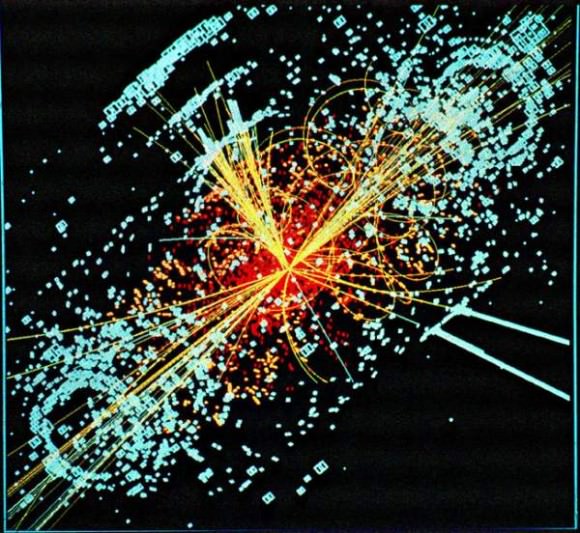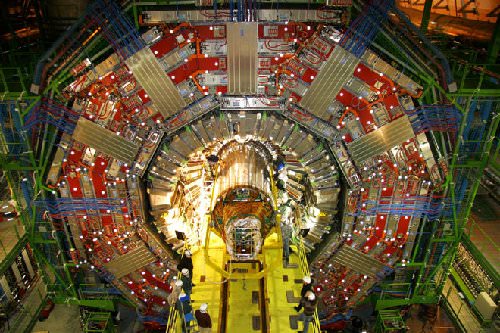[/caption]
From an Imperial College London press release:
Physicists say they are closer than ever to finding the source of the Universe’s mysterious dark matter, following a better than expected year of research at the Compact Muon Solenoid (CMS) particle detector, part of the Large Hadron Collider (LHC) at CERN in Geneva.
The scientists have now carried out the first full run of experiments that smash protons together at almost the speed of light. When these sub-atomic particles collide at the heart of the CMS detector, the resultant energies and densities are similar to those that were present in the first instants of the Universe, immediately after the Big Bang some 13.7 billion years ago. The unique conditions created by these collisions can lead to the production of new particles that would have existed in those early instants and have since disappeared.
The researchers say they are well on their way to being able to either confirm or rule out one of the primary theories that could solve many of the outstanding questions of particle physics, known as Supersymmetry (SUSY). Many hope it could be a valid extension for the Standard Model of particle physics, which describes the interactions of known subatomic particles with astonishing precision but fails to incorporate general relativity, dark matter and dark energy.

Dark matter is an invisible substance that we cannot detect directly but whose presence is inferred from the rotation of galaxies. Physicists believe that it makes up about a quarter of the mass of the Universe whilst the ordinary and visible matter only makes up about 5% of the mass of the Universe. Its composition is a mystery, leading to intriguing possibilities of hitherto undiscovered physics.
Professor Geoff Hall from the Department of Physics at Imperial College London, who works on the CMS experiment, said, “We have made an important step forward in the hunt for dark matter, although no discovery has yet been made. These results have come faster than we expected because the LHC and CMS ran better last year than we dared hope and we are now very optimistic about the prospects of pinning down Supersymmetry in the next few years.”
The energy released in proton-proton collisions in CMS manifests itself as particles that fly away in all directions. Most collisions produce known particles but, on rare occasions, new ones may be produced, including those predicted by SUSY – known as supersymmetric particles, or ‘sparticles’. The lightest sparticle is a natural candidate for dark matter as it is stable and CMS would only ‘see’ these objects through an absence of their signal in the detector, leading to an imbalance of energy and momentum.
In order to search for sparticles, CMS looks for collisions that produce two or more high-energy ‘jets’ (bunches of particles traveling in approximately the same direction) and significant missing energy.
Dr. Oliver Buchmueller, also from the Department of Physics at Imperial College London, but who is based at CERN, said, “We need a good understanding of the ordinary collisions so that we can recognise the unusual ones when they happen. Such collisions are rare but can be produced by known physics. We examined some 3 trillion proton-proton collisions and found 13 ‘SUSY-like’ ones, around the number that we expected. Although no evidence for sparticles was found, this measurement narrows down the area for the search for dark matter significantly.”
The physicists are now looking forward to the 2011 run of the LHC and CMS, which is expected to bring in data that could confirm Supersymmetry as an explanation for dark matter.
The CMS experiment is one of two general purpose experiments designed to collect data from the LHC, along with ATLAS (A Toroidal LHC ApparatuS). Imperial’s High Energy Physics Group has played a major role in the design and construction of CMS and now many of the members are working on the mission to find new particles, including the elusive Higgs boson particle (if it exists), and solve some of the mysteries of nature, such as where mass comes from, why there is no anti-matter in our Universe and whether there are more than three spatial dimensions.


Supersymmetry is nice – it’ll be good to see if it bears up under the watchful eyes of the LHC.
I can’t help but feel that if aspects of it are in fact verified, I’m going to led to the conclusion that the universe has been created by some super-intelligent stoner aliens in a high-school equivalent lab in some higher dimensional universe. They’d be like:
“DUDE! Lets, like, pair up each of the elementary Bosons with corresponding Fermions, but wait, like, get this – we’ll BREAK THE GODDAMN SYMMETRY between them so that it’ll confuse the s___ out of anyone trying to make sense of it all.”
“TOTALLY DUDE! – that’s a RAD idea!”
Sadistic bastards.
So now your gonna figure out inert matter outside the base field of a so called black-hole and by what smashing protons together GL guys
Not “we” here specifically, unless you mean we all in general; IIRC 53 nations is in on the CMS so chances are you are participating too.
Juts out of curiosity, since you don’t use mundane particle collisions, what alternative methods are you trying then?
In related news, Tevatron is going to kick the bucket soon.
That soon to be abandoned race between the oldster and the new, more competent, kid on the block reminds of Opportunity and Curiosity competing to be the first to the oldest fluvial sediments on Mars.
Sad, but good to be moving on. Tevatron had a very good last couple of years.
Now we need a new electron-positron collider to examine in detail the work that will be done at the LHC. Maybe they can start building THAT puppy!
“We have made an important step forward in the hunt for dark matter, although no discovery has yet been made. These results have come faster than we expected because the LHC and CMS ran better last year than we dared hope and we are now very optimistic about the prospects of pinning down Supersymmetry in the next few years.”
– how delightfully vague.
– how delightfully negative.
It’s a delightful marketing. 🙂
I’m not entirely sure the word “compact” should be in that things name.
I vote for: “Stupidly Big Muon Solenoid (CMS) detector”.
Supersymmetry is a way that bosons and fermions are framed so they transform amongst each other. It is also a topological result which permits internal symmetries of gauge fields to exist with the external symmetries (Lorentz group) of spacetime. This is forbidden in a naïve manner by the Coleman-Mandula theorem. The vacuum energy for bosons is positive and for fermions is negative. The supersymmetric pairing of particles then means the net vacuum energy is zero.
Dark matter is probably a condensate state of the supersymmetric pairs of the photon, Z, Higgs and the neutrino. The superpartners of these particles in their graded doublets have the same quantum numbers, and then form a type of oscillating field configuration between their quantum states. At low energy the symmetry breaking or mass splitting of this degeneracy forms a type of mass-matrix for this oscillation. We should then find that at partial supersymmetry the occurrence of this neutralino state. The PAMELA detector has found Tev spectra of decay particle which is where the neutralino should exist.
LC
Lol, whaaaat?
Your comments are always very interesting, albeit tough for the non-initiate, but this one especially flew a mile over my head.
Thanks I guess? 😉
Yah, he blew my mind on this one too.
UF
If dark matter composes 25% of the mass of the universe, and visible matter makes up an additional 5%, what makes up the other 70%?
Like others I found the statement about being confident they could soon confirm or deny a theory rather amusing. They don’t know which? But the rest of the article does help. It appears that they are getting the *kind* of data they expected out of their experiments, and the content of that data will help them decide. This makes more sense when you remember that most of the time, big new experiments like these tend not to answer our questions but rather point out we haven’t been asking the right ones in the first place.
This article here does says “visible matter makes up an additional 5%”.
I don’t recalled reading that exact point anywhere.
I do remember reading, though, that the remaining 70-odd% is thought to consist of dark energy.
The statement about being confident they could soon confirm or deny a theory do need to be put in the proper perspective. There are more than TRUE and FALSE in this case, there is also DO NOT KNOW or rather CAN NOT SELECT THE BETTER OF TWO theories. Remember that no ultimate theory yet exists, therefor no theory is TRUE in all domains, some are true in a limited domain but becomes gradually worse outside – Quantum Theory and General Relativity as good examples. We already know neither of these two are correct at all times in all domains.
From the multitude of current theories (pluralis) the new testresults will confirm and reject predictions, siginificantly redusing the number of remaining theories.
The other 70% is dark energy. This is the vacuum energy which is responsible for the exponential expansion of the universe. The scale factor may be shown to obey an exponential growth
a = exp(sqrt{L/3}t)
the L is “lambda or /\” which is due to the quantum vacuum energy. This vacuum energy has an energy density e = E/vol, which also obeys a rule that the pressure is the negative of the energy, pc = -e, for c = speed of light. This negative pressure is why the universe exponentially expands.
LC